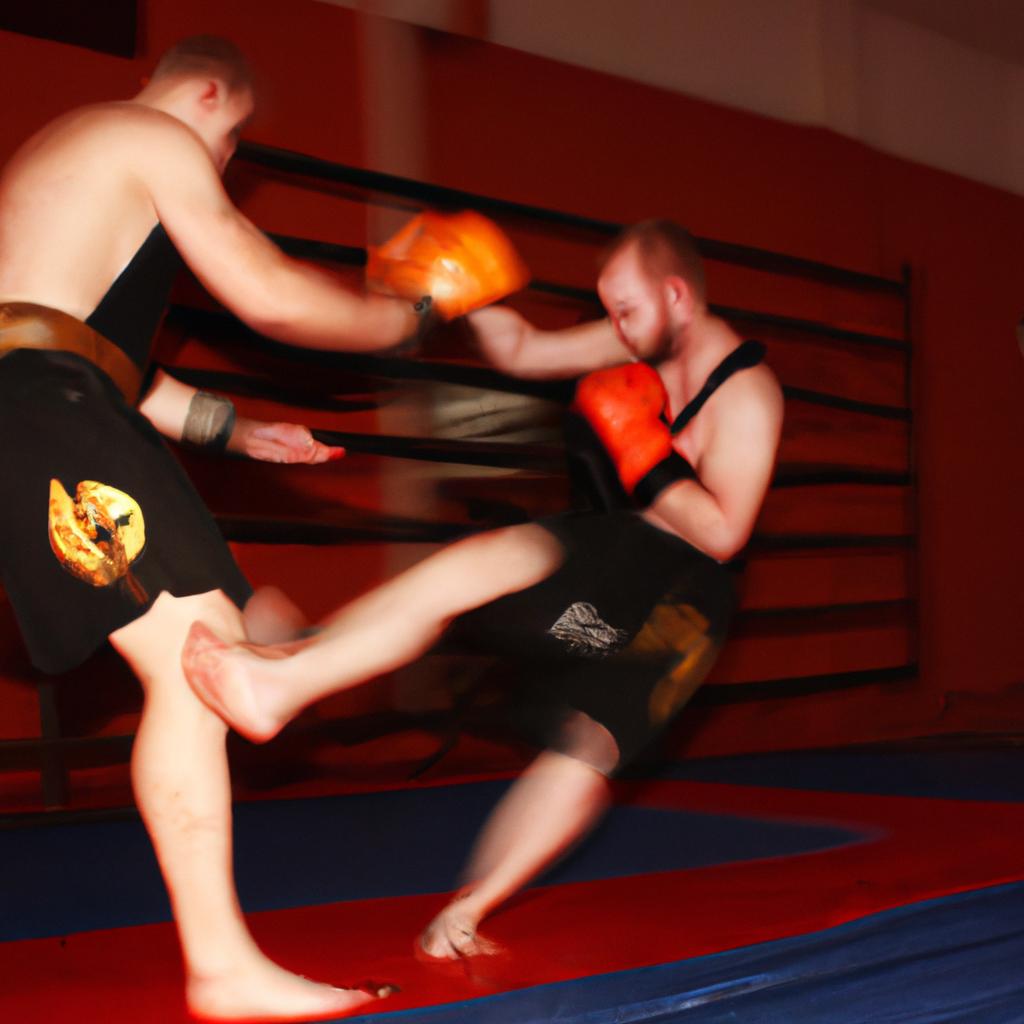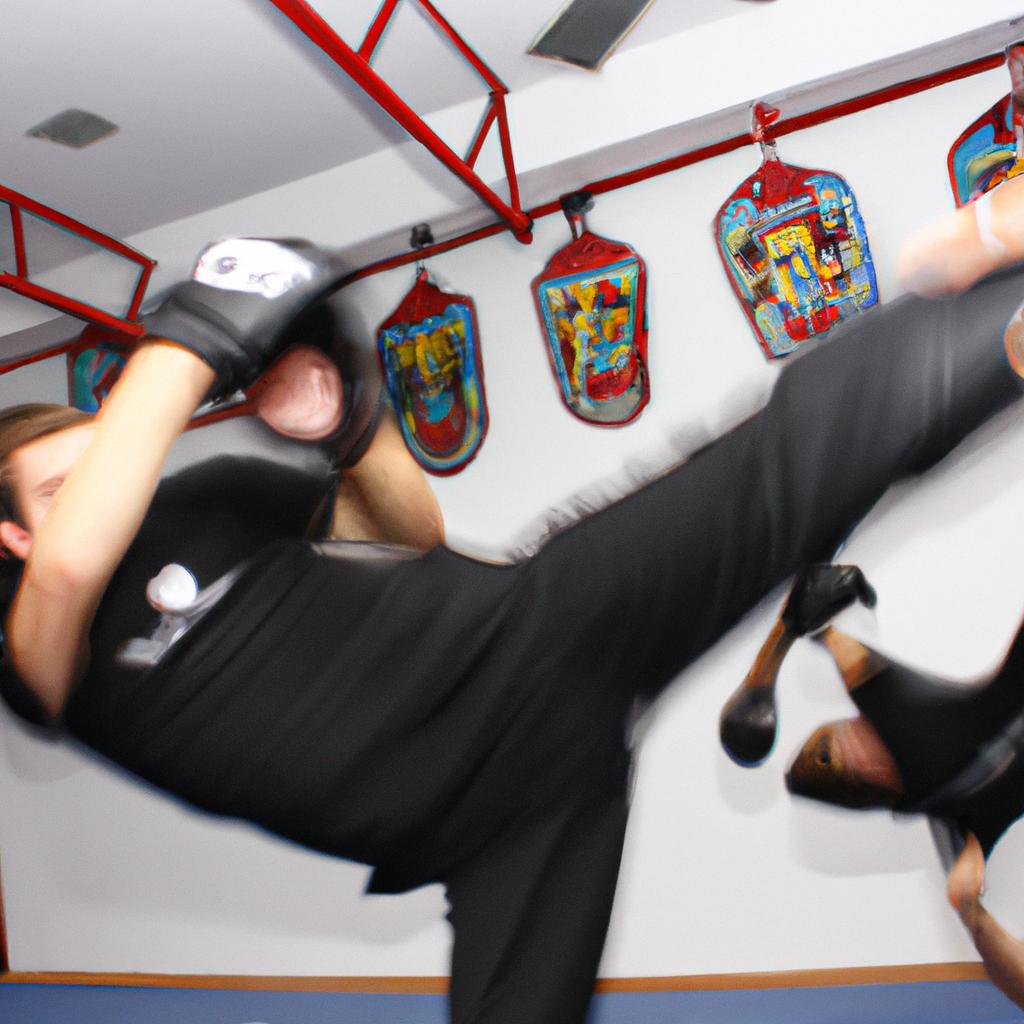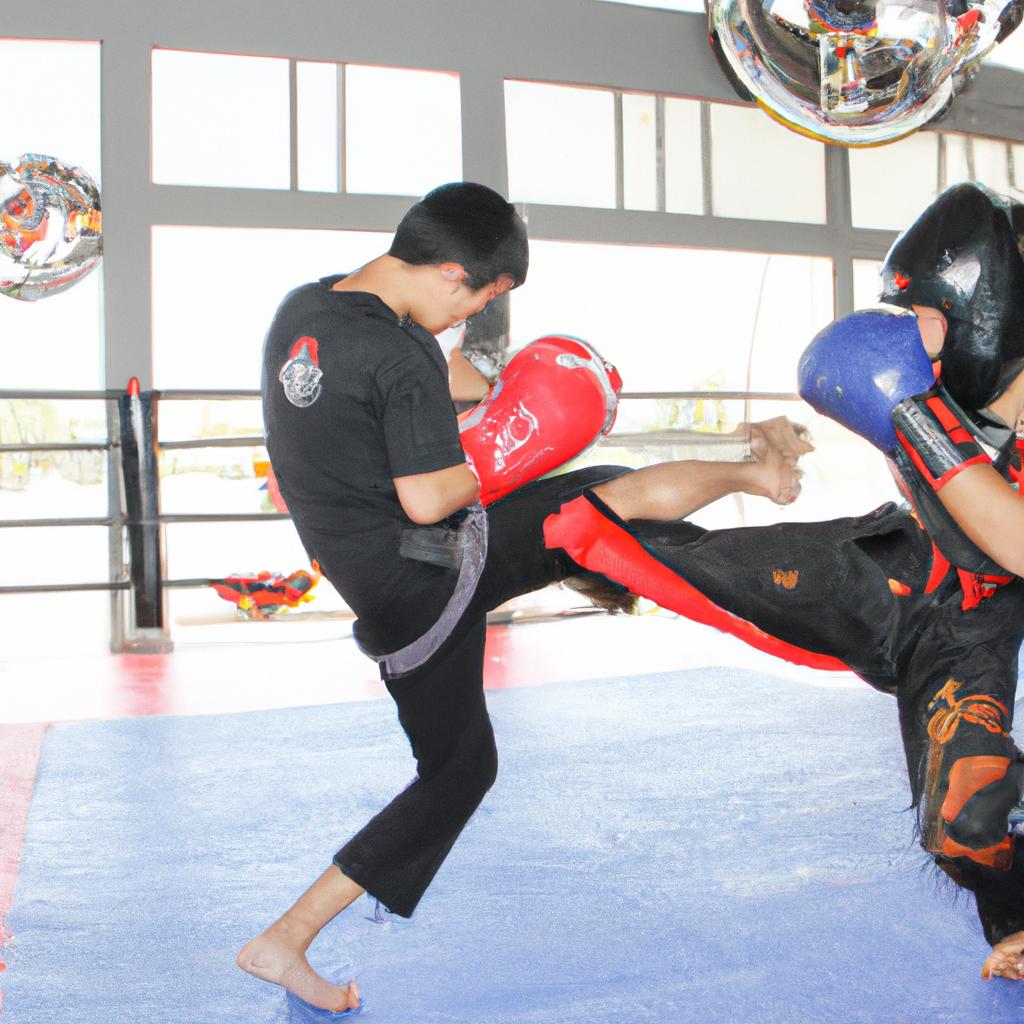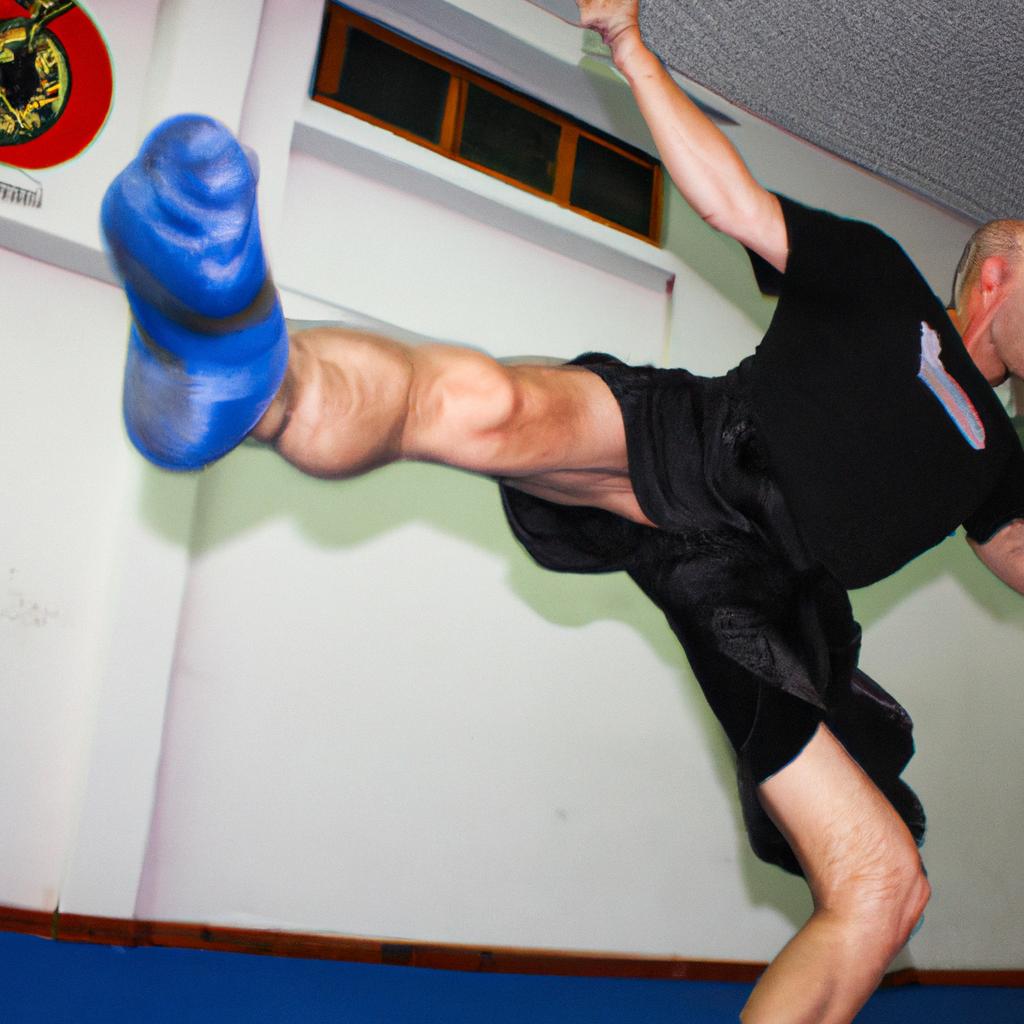In the world of mixed martial arts (MMA), mastering Muay Thai techniques is an essential skill for fighters looking to elevate their game. The art of eight limbs, as it is often called, encompasses a range of striking techniques that utilize fists, elbows, knees, and shins. By incorporating these techniques into training drills and exercises, fighters can enhance their overall proficiency in the ring or cage. To illustrate the effectiveness of such drills, consider the hypothetical case study of a novice MMA fighter named Alex who struggled with his stand-up game but experienced significant improvement after implementing Muay Thai training drills.
Muay Thai, originating from Thailand, has gained immense popularity due to its practicality and effectiveness in combat sports like MMA. Its emphasis on powerful strikes delivered from close quarters allows fighters to engage opponents both defensively and offensively. Training drills are designed to simulate real fighting scenarios while honing specific skills required in Muay Thai. For instance, one common drill involves practicing knee strikes against a heavy bag or focus mitts, replicating the experience of engaging an opponent at close range. This not only helps improve accuracy and power but also develops crucial balance and stability required for executing such strikes effectively during fights.
The Importance of Training Drills and Exercises in MMA
Imagine a novice mixed martial arts (MMA) fighter stepping into the ring for the first time. Despite having a basic understanding of various fighting styles, they lack the necessary skills to effectively execute their techniques under pressure. This scenario highlights the vital role that training drills and exercises play in developing mastery in MMA.
Training drills and exercises serve as essential tools for honing one’s skills and enhancing overall performance in MMA. By consistently engaging in purposeful practice, fighters cultivate muscle memory, improve reaction times, and enhance physical conditioning—critical elements for success inside the octagon. Moreover, these drills provide an opportunity for athletes to familiarize themselves with different scenarios they may encounter during a fight, allowing them to develop strategies and tactics accordingly.
To illustrate further, let us consider a hypothetical case study involving two fighters preparing for an upcoming bout. Fighter A solely relies on sparring sessions without incorporating specific training drills or exercises into their routine. In contrast, Fighter B diligently follows a comprehensive training program that incorporates various drilling techniques such as shadowboxing, bag work, pad work, and partner drills. When it comes to fight night, Fighter B demonstrates superior technique execution and displays better adaptability due to their extensive drilling experience.
Engaging in regular training drills not only improves technical proficiency but also enhances several crucial aspects of an athlete’s performance:
- Physical Conditioning: Intense workouts involving calisthenics, cardio circuits, weightlifting routines help build strength, endurance, agility.
- Mental Toughness: Repeatedly practicing complex movements fosters mental resilience by pushing athletes beyond their comfort zones.
- Reaction Times: Incorporating speed drills sharpens reflexes and allows fighters to respond quickly to unexpected situations.
- Strategy Development: Through scenario-based drilling exercises, fighters learn how to anticipate opponents’ moves and formulate effective counterattacks.
By embracing diverse training methods encompassed within these four pillars – physical conditioning, mental toughness, reaction times, and strategy development – MMA fighters can unlock their full potential in the ring.
In the subsequent section, we will explore how Muay Thai techniques specifically contribute to enhancing striking power in MMA. By incorporating these techniques into training drills and exercises, fighters can further develop their skills and maximize their performance inside the octagon.
Enhancing Striking Power with Muay Thai Techniques
Transitioning from the importance of training drills and exercises in MMA, let us now delve into how Muay Thai techniques can enhance striking power. To illustrate this point, imagine a fighter named Alex who has been struggling with his striking abilities. Despite possessing good technique, he lacks the necessary power to effectively execute strikes during fights. By incorporating Muay Thai techniques into his training regimen, Alex is able to significantly improve his striking power and become a more formidable opponent.
There are several key elements within Muay Thai that contribute to the enhancement of striking power:
- Hip Rotation: Emphasizing hip rotation when executing strikes allows fighters to generate maximum force behind their punches and kicks.
- Proper Weight Transfer: Learning how to transfer weight efficiently from one foot to another enables fighters to deliver powerful strikes while maintaining balance and stability.
- Utilization of Body Mechanics: Understanding how to utilize body mechanics such as torque and angular momentum helps fighters optimize their strength and leverage for increased striking power.
- Conditioning Exercises: Incorporating conditioning exercises specific to Muay Thai, such as heavy bag work or pad drills, not only improves overall fitness but also enhances muscular endurance required for generating impactful strikes.
To further highlight the effectiveness of Muay Thai techniques in enhancing striking power, consider the following table showcasing a comparison between traditional boxing techniques and those derived from Muay Thai:
| Technique | Boxing | Muay Thai |
|---|---|---|
| Punches | Focus on upper body | Full-body engagement |
| Kicks | Not utilized | Integral component |
| Elbows | Limited use | Devastating weapon |
| Knee Strikes | Not utilized | Highly effective |
This comparison demonstrates that by incorporating Muay Thai techniques into training drills and exercises, fighters have access to a wider range of tools that can be employed strategically during combat scenarios. The inclusion of knee strikes and elbow attacks, in particular, significantly increases the potential for inflicting damage and overpowering opponents.
In summary, by integrating Muay Thai techniques into their training routines, fighters like Alex can enhance their striking power and become more skilled competitors. The emphasis on hip rotation, weight transfer, body mechanics, and specific conditioning exercises enables fighters to generate maximum force behind strikes while improving overall fitness levels. With a wider arsenal of techniques at their disposal, including devastating knee strikes and powerful elbow attacks, fighters are better equipped to excel in MMA competitions. In the subsequent section about “Mastering Clinch and Knee Techniques for Close Range Combat,” we will explore how these skills can be further honed for close-range combat situations.
Mastering Clinch and Knee Techniques for Close Range Combat
Building upon the foundation of enhancing striking power, mastering clinch and knee techniques is essential for close-range combat. By incorporating the principles of Muay Thai into your training regimen, you will develop a comprehensive skill set that allows you to dominate in various scenarios.
To illustrate the effectiveness of these techniques, consider the following hypothetical scenario: imagine being pinned against the cage by an opponent who has superior wrestling skills. In this situation, having a strong grasp of clinch and knee techniques can be a game-changer. By utilizing precise timing and technical proficiency, you could swiftly transition from a defensive position to launching devastating strikes with your knees or elbows. This ability not only neutralizes your opponent’s advantage but also creates opportunities for counterattacks.
Incorporating Muay Thai elements into your training drills and exercises provides numerous benefits when it comes to clinching and knee strikes:
- Increased control: Properly executed clinches enable you to establish dominance over your opponent by controlling their movements and limiting their options.
- Strategic positioning: Understanding different clinch positions empowers you to dictate the flow of the fight, allowing you to execute effective strikes while minimizing potential risks.
- Versatile strikes: Utilizing knees as offensive weapons offers versatility in terms of target selection – whether aiming for the body, head, or legs – enhancing your overall offensive repertoire.
- Effective defense: Proficiency in clinching enables efficient defense against takedowns or grappling attempts, providing valuable time to strategize alternative moves.
| Benefits of Incorporating Muay Thai |
|---|
| – Increased control |
| – Strategic positioning |
| – Versatile strikes |
| – Effective defense |
By immersing yourself in rigorous training sessions focused on mastering clinch and knee techniques inspired by Muay Thai practices, you equip yourself with invaluable tools that elevate your overall MMA mastery. These techniques allow you to dominate close-range combat situations, effectively neutralizing your opponents’ strengths and creating opportunities for victory.
Developing Effective Footwork and Movement is the next crucial aspect in unleashing your full potential as an MMA fighter, ensuring that you maintain optimal positioning and create openings for strikes or defensive maneuvers without compromising stability.
Developing Effective Footwork and Movement
Transitioning from mastering clinch and knee techniques for close range combat, it is crucial to develop effective footwork and movement in order to enhance overall performance in MMA. Footwork plays a significant role in dictating the pace of a fight and creating openings for strikes or takedowns. By honing one’s footwork skills, fighters can effectively control the distance between themselves and their opponents while maintaining balance and agility.
To illustrate the importance of footwork, consider an example where an MMA fighter faces an opponent known for his powerful punches but limited grappling ability. The fighter recognizes that by utilizing superior footwork, he can avoid getting drawn into striking exchanges and instead focus on taking advantage of his opponent’s weaknesses on the ground. This strategic use of footwork enables him to control the rhythm of the fight and dictate where the engagement takes place.
In developing effective footwork and movement, there are several key aspects that fighters should prioritize:
- Maintaining proper stance: A solid foundation begins with adopting a balanced fighting stance that allows for quick movements in any direction.
- Utilizing angles: Moving laterally or at different angles helps create advantageous positions while making it harder for opponents to land clean shots.
- Pivoting: Proper pivoting technique allows fighters to generate power in their strikes while minimizing telegraphing their intentions.
- Incorporating feints: Feinting movements can deceive opponents, opening up opportunities for counterattacks or takedowns.
To further understand these concepts, refer to the table below showcasing how various footwork techniques contribute to successful outcomes in an MMA match:
| Footwork Technique | Benefit |
|---|---|
| Lateral Movement | Creates angles for better attack positioning |
| In-and-out Stepping | Controls distance between opponents |
| Shuffle Step | Facilitates rapid directional changes |
| Pivot | Generates power behind strikes |
By diligently practicing these footwork techniques, mixed martial artists can enhance their overall performance and increase the likelihood of success in the cage. Developing effective footwork not only improves mobility but also provides a tactical advantage by enabling fighters to control the pace and positioning of the fight, ultimately contributing to strategic victory.
As footwork lays the foundation for successful engagement, it seamlessly leads us to explore the vital aspect of utilizing elbows and kicks for devastating strikes.
Utilizing Elbows and Kicks for Devastating Strikes
Section Title: Enhancing Striking Power with Clinching Techniques
Imagine a scenario where an MMA fighter finds themselves caught in a clinch against a formidable opponent. With their back pressed against the cage, they must rely on their mastery of Muay Thai techniques to gain the upper hand and deliver devastating strikes. This section will delve into the art of clinching, exploring its significance in enhancing striking power within mixed martial arts.
Clinching, a fundamental aspect of Muay Thai, involves close-range grappling combined with strategic positioning and effective striking. By utilizing clinching techniques, fighters can control their opponent’s movement while setting up powerful strikes or takedowns. One such technique is the double collar tie, where both hands grip behind the opponent’s head. This allows for better control over their posture and opens opportunities for various attacks.
To fully comprehend the impact of clinching on striking power, it is crucial to understand its benefits:
- Increased stability and balance due to body-to-body contact.
- Enhanced control over opponents’ movements by restricting their mobility.
- Creation of angles for devastating knee strikes and elbows.
- Utilization of off-balancing techniques to set up powerful punches or kicks.
In addition to these advantages, incorporating footwork into clinching adds another layer of complexity to one’s offensive arsenal. Fighters who seamlessly combine footwork with clinch work can swiftly maneuver around opponents while maintaining dominant positions. Implementing pivots and directional changes during a clinch enables fighters to create openings for strikes or even disengage from unfavorable situations.
Table: Key Techniques for Effective Clinching
| Technique | Description |
|---|---|
| Double Collar Tie | Gripping both hands behind the opponent’s head |
| Off-Balancing | Disrupting an opponent’s balance through leverage |
| Angling | Creating advantageous positions for strikes |
| Footwork Integration | Combining footwork with clinch work for better control |
In conclusion, the mastery of clinching techniques is invaluable in maximizing striking power within mixed martial arts. By incorporating close-range grappling and strategic positioning, fighters gain control over their opponents’ movements while creating openings for devastating strikes. Additionally, integrating footwork into clinching adds another layer of complexity to one’s offensive repertoire. With these skills honed, fighters can confidently transition to the next section: Training Sparring and Pad Work for Practical Application.
Note: The subsequent section will focus on training methods that allow practitioners to apply their learned techniques in practical scenarios such as sparring and pad work.
Training Sparring and Pad Work for Practical Application
Building upon the devastating strikes achieved through utilizing elbows and kicks, the next critical aspect of unleashing mastery in Muay Thai techniques is training sparring and pad work for practical application. By incorporating these dynamic elements into your training regimen, you will develop the necessary skills to effectively apply your techniques in a real-life combat scenario.
Case Study Example: Imagine a novice fighter who has just learned various strikes and combinations using elbows and kicks. While their technique may be proficient on the pads or during shadowboxing drills, they struggle to execute those same moves with confidence when faced with an opponent in live sparring. This highlights the importance of integrating sparring and pad work into one’s training routine.
Paragraph 1:
Sparring allows fighters to apply their newly acquired skills against a fully resisting opponent in a controlled environment. It simulates realistic fighting scenarios while providing opportunities for practitioners to refine their timing, distance management, and defensive strategies. Through regular sparring sessions, fighters can gauge their progress, identify weaknesses in their game, and adapt accordingly. Moreover, it fosters mental fortitude by enhancing situational awareness and decision-making abilities under pressure.
- Cultivate discipline and focus.
- Enhance self-confidence and assertiveness.
- Improve physical fitness levels.
- Develop camaraderie within the training community.
Paragraph 2:
Pad work serves as another vital element of training that complements sparring. Working with pads enables fighters to practice striking combinations at full power without risking injury to themselves or others. It allows trainers to provide immediate feedback on technique precision, speed, accuracy, and footwork. Additionally, pad work enhances hand-eye coordination and helps build muscle memory by repeatedly executing specific sequences of strikes.
Emotional Table:
| Benefits of Pad Work |
|---|
| Increased cardiovascular endurance |
| Enhanced agility |
| Improved muscular strength |
Paragraph 3:
Incorporating both sparring and pad work into your training routine creates a balanced approach to mastering Muay Thai techniques. Sparring challenges fighters to apply their skills in real-time, ensuring they can adapt to different opponents and fight scenarios. Meanwhile, pad work hones technique precision and power, enabling practitioners to deliver devastating strikes consistently. By consistently practicing these elements of practical application, fighters will gradually develop the necessary attributes to excel in the sport.
By adopting these training methods and diligently applying them throughout your journey, you can maximize your potential as an MMA fighter while furthering your mastery of Muay Thai techniques. Embrace the physical challenges, mental fortitude required, and enjoy the rewards that come with honing your skills through sparring and pad work.




